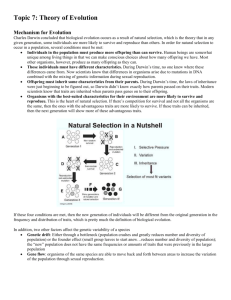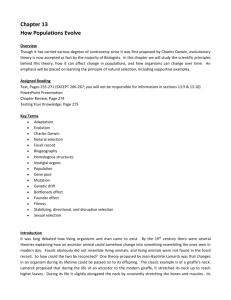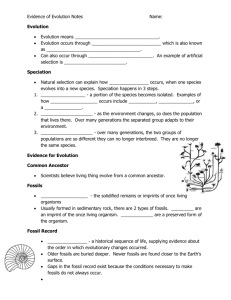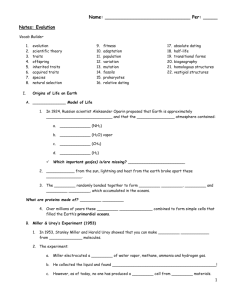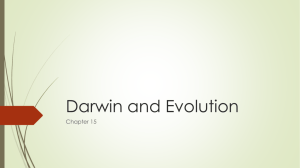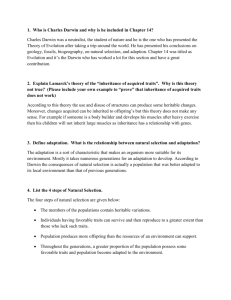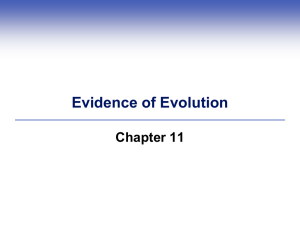evolution powerpoint 2014
advertisement
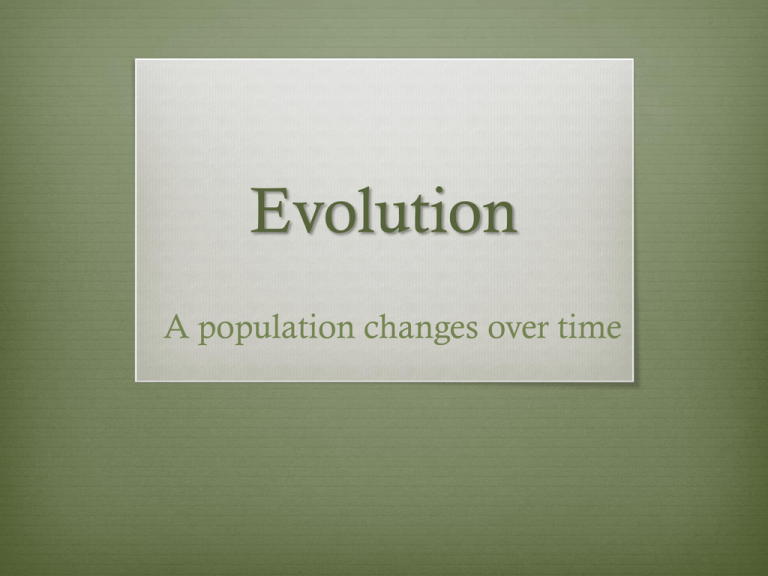
Evolution A population changes over time Charles Darwin (1809- 1882) A. Published Origin of Species in 1859 - 22 years old, HMS Beagle - Voyage of 5 years 2. Galapagos Islands B. Darwin’s Influences 1. Lamarck (early 1800s) i. Believed that animals change over timecontrary to popular belief! ii. Inheritance of Acquired Characteristics: characteristics can be gained through use and passed on to offspring Kayan “giraffe” women Traits Must be Genetic to Pass On! You cannot “ force” yourself to have a characteristics Example #1: You cannot force yourself to be lactose tolerant Example #2: Bacteria CANNOT acquire resistance to antibiotics Note: New traits cannot be created during your lifetime Only genes can be passed on 2. Lyell • Previously, idea was that Earth itself is less than 10,000 years old • Proposed that gradual and observable geologic processes such as erosion could explain the physical features of today's Earth taking place over thousands or millions of years i. Earth 4.5 billion years old 3.5 billion years first life (single celled) C. Fossils: found on Darwin’s trip. Shows earth is old – there is enough time for descent with modification to occur II. Darwin’s Finches A. Biogeography- geographic distribution of life forms B. Galapagos Islands- Volcanic islands off the coast of South America 1. Species were slightly different than the ones on the mainland C. Finches- different beaks depending on the food available i. Cactus-eating finch:more point beak ii. Insect-eating finch: sharp ( trees) iii. Types of seeds D. All descended from one mainland Finch DESCENT WITH MODIFICATION from a COMMON ANCESTOR VIDEO: https://www.youtube.com/watch?v=flDL2ZQtK8I • The Galápagos tortoise or Galápagos giant tortoise the largest living species of tortoise and 10th-heaviest living reptile, reaching weights of over 400 kg (880 lb) and lengths of over 1.8 meters (5.9 ft). Shell size and shape vary between populations- humidity, dryness etc. Only swimming marine iguana Blue Footed Boobie Blue feet and dancing to impress the female- mating ritual Frigatebird- Do this to distract others and take their prey III. Natural Selection A. Definition: mechanism for evolutionary change B. Components: 1. Inherited variations: Mutations- changes in DNA Meiosis 2. Struggle for existence 3. Adaptations (traits that help an organism be more suited to the environment) increase survival and reproductive success 4. Reproduction- Genes for adaptations increase in each generation – (Fitness- reproductive success) Darwin’s Conclusions a. Too many organisms are produced b. All individuals in a species have variation c. All individuals must struggle for existence, and those with favorable variation have an advantage over others (fight for food, mate, habitat, etc.) d. Variation that is heritable, over time produce species. e. Successive inheritance of favorable variation over vast stretches of geological time produce new species. Descent with Modification Survival of the fittest IV. Artificial Selection Breeder choices which traits to perpetuate (dogs descended from wolves). Canis familiaris comes from Canis lupis domesticated 14,000 years ago. Artificial Selection selective breeding of domesticated plants and animals to produce offspring with genetic traits that HUMANS VALUE The result of Natural Selection is a population adapted to the local environment Evidence for Evolution A. Fossils B. Biogeographical C. Anatomical D. Biochemical E. Embryology F. Examples- Antibiotic A. Fossils 8 million years ago humans chimpanzees : dozen human-like species called hominids The modern form of Homo sapiens first appeared about 100,000 years ago. This species is distinguished by large brain size, mouth not as protruding. Begin with bipedal ancestor- skulls begin when humans began to walk on two feet A. Fossil Record A fossil is preserved remains or markings left by organisms that lived in the past Many fossils are cast in sedimentary rock Examples: Imprint Mineralized Frozen Amber THE FOSSIL RECORD Dating Fossils i. Radiometric Age - Measurement of isotopes in objects ii. Relative Age - Age based on layers “Lucy” 3.2 million year old hominid fossil Australopithecus afarensis Significant because skeleton shows evidence of small skull capacity like that of apes and of upright bipedal posture like humans B. Biogeography Traits of organisms are directly linked to the geography and environmental conditions of an area Example: flightless birds, south hemisphere A mammal of an order (Marsupialia) whose members are born incompletely developed and are typically carried in a pouch C. Anatomical Evidence 1. Homologous Structure: Structures that are similar because they are inherited from a common ancestor C. Anatomical Evidence 2. Analogous Structures: features are similar in function but not in structure. They do not derive from a recent common ancestor but in response to a similar environment. ANALOGOUS STRUCTURES More Examples Example: Insects and birds both have wings to fly, although their wing structure is very different structure. The fat-insulated, streamline shapes of seals (mammals) and of penguins (birds) is another example. C. Anatomical Evidence 3. Vestigial structures: no longer have function. occur because organism inherit anatomy from their ancestors. Examples: Some snakes have small hindlimbs Humans: Appendix, wisdom teeth, tail bone THE APPENDIX VESTIGIAL STRUCTURE D. Biochemical/Molecular 1. Living organisms use DNA, and many identical enzymes (same 20 amino acids) 2. Degree of similarity of DNA sequence or amino acid structure based on how closely related 1. Similar DNA suggests an evolutionary relationship 2. Hemoglobin 3. Cytochrome C Our closest DNA relative is the chimpanzee, with whom we share 98% DNA sequence similarity E. Embryology ( Development) 1. Embryos of closely related organisms often have similar stages in development. III. OTHER CONCEPTS IN EVOLUTION A. Antibiotic- and Pesticide-Resistance 1. Antibiotic- medicine that kills/slows the growth of bacteria 2. Some bacteria with natural resistance will not be killed off by the antibiotics and can re-grow a resistant population quickly Similar fate happens to microbes when exposed to cleaners and disinfectants When pesticides are used, some insects will already have a natural resistance and survive the spraying, then reproduce more insects that inherit the resistance genes. Eventually the same pesticides will not have the same effect as before. IV. Types of Evolution A. Divergent Evolution: consequence of adaptive radiation- organisms sharing a common ancestor evolve to become different according to environmental pressures B. Convergent evolution: arises when there are some sort of ecological or physical driver toward a similar solution, even though the structure or function has arisen independently. Ex: sharks and dolphins share analogous body plans, yet have different ancestral backgrounds (fish versus mammal)



